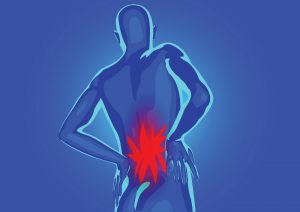 It is estimated eight of 10 adults have low back pain at some time in their lives.
It is estimated eight of 10 adults have low back pain at some time in their lives.
For many individuals, episodes of back pain are self-limited. Patients who continue to have back pain beyond the acute period (four weeks) have subacute back pain (lasting between four and 12 weeks) and may go on to develop chronic back pain (persists for more than 12 weeks). It is rare for back pain to be an indication of something more serious.
Mistakenly, most sudden onset of back pain is labeled a back sprain or strain. A sprain or strain occurs when muscles and ligaments are stretched too far, and tears damage the tissue. The back typically does not go through enough range of motion to result in sprains or strains.
It is much more common to have a degenerative process, such as degenerative disc disease or arthritis of the spine that becomes inflamed by lifting or overworking the area. It is important to understand this is a chronic condition, causing reoccurring pain. Patients need to be educated about rehabilitative exercises and other ways to avoid and treat reoccurrences.
Some risk factors associated with an increased incidence of back pain include smoking, obesity, age, female gender, physically strenuous work, sedentary work, psychologically strenuous work, low educational attainment, Workers’ Compensation insurance, job dissatisfaction, and psychologic factors, such as anxiety and depression. Overdoing it at the gym or golf course is one of the most common causes of overextended muscles leading to low back pain. You’re especially vulnerable if you tend to be inactive during the workweek and then spend an hour at the gym or softball field on the weekend.
Symptoms requiring urgent care include loss of bowel or bladder control, numbness in the groin area, leg weakness, fever and pain when coughing or urinating. If you have any of these symptoms along with your back pain, contact your doctor.
Also contact your doctor right away if you have back pain and you have a history of cancer, unintentional weight loss, long-term steroid use, weak immune system, history of IV drug use, or your pain gets worse with rest.
Unless low back pain is caused by a serious medical condition, a rapid recovery is expected, even if there is a bulging or herniated disc. The body breaks down bulging discs, taking pressure off the nerve.
Basic guidelines for treatment
Many people are afraid they will hurt their back further or delay recovery by remaining active. However, remaining active is one of the best things you can do. In fact, prolonged bed rest is not recommended. Although high-impact activities should be avoided, it is fine to continue regular day-to-day activities. Using heat can help during the first few weeks. Over-the-counter medicine, such as aspirin, ibuprofen (Advil, Motrin) and naproxen (Aleve), may work better than acetaminophen (Tylenol) for low back pain. They can be taken together, but you should consult your doctor first. A program of exercises can help to increase back flexibility and strengthen the muscles supporting the back. Although starting back exercises or stretching immediately after a new episode of low back pain might temporarily increase the pain, the exercise may reduce the total duration of pain and prevent recurrent episodes.
Recommended activities include those that involve strengthening and stretching, such as walking, swimming, use of a stationary bicycle and low-impact aerobics. Avoid activities that involve twisting or bending, are high-impact, or make the back hurt more. Some specific exercises may help strengthen the muscles of the lower back. People with frequent episodes of low back pain should continue these exercises indefinitely to prevent new episodes.
Dr. Russell Homewood’s Biography
Dr. Homewood chose Family Practice because he values long-lasting relationships with his patients. A perfect day in the clinic involves providing excellent medical care, while also visiting with old friends. He is well known for his empathetic, fun-loving personality and down-to-earth bedside manner that puts his patients at ease. He frequently takes time to explain a patient’s diagnosis and clarifies any confusing information from a specialist visit.
Dr. Homewood completed his undergraduate degree from Brigham Young University and his Doctor of Osteopathy from Kirksville College of Osteopathic Medicine, ranking in the top 20th percentile. He completed his residency in Family Medicine at Phoenix Baptist Hospital in 1999. He is board certified in Family Medicine. After beginning his career with larger medical groups, he opened his own practice, Homewood Family Medicine, in 2001. This has allowed him to enjoy building patient relationships.
Certifications include National Board of Osteopathic Medical Examiners, and he is a Diplomat for the American Board of Family Practice. He is a member of the American Osteopathic Association, Arizona Osteopathic Medical Association—Delegate District 4 and the American Diabetes Association.
Dr. Homewood enjoys spending time with his beautiful wife, Kim, and their children. Time permitting, he engages in activities including biking, running, skiing, hiking and travel.
For more information, or to make an appointment with Dr. Russell Homewood, call (480) 999-0049.


1 comment
Good tips and advice about back pain. I found a lot of new ideas from your article. I am suffering from lower back pain from last 5 months. Your advice will help me to relieve my back pain. Thank you very much.